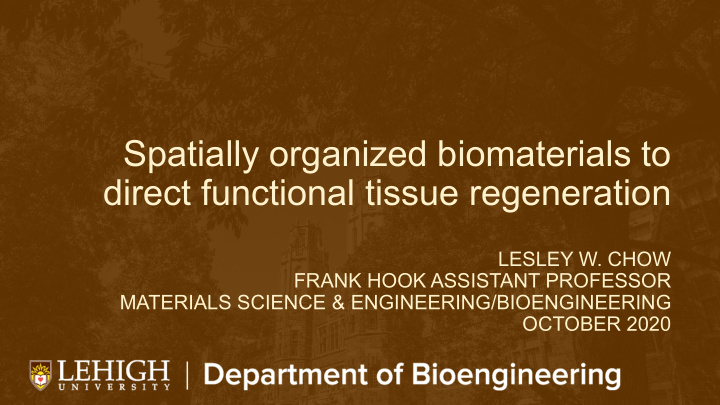



Spatially organized biomaterials to direct functional tissue regeneration LESLEY W. CHOW FRANK HOOK ASSISTANT PROFESSOR MATERIALS SCIENCE & ENGINEERING/BIOENGINEERING OCTOBER 2020
Lesley W. Chow, PhD EDUCATION AND TRAINING • B.S., Materials Science and Engineering, University of Florida • Ph.D., Materials Science and Engineering, Northwestern University • Postdoc, Materials & Bioengineering, Imperial College London KEY PUBLICATIONS • P. Camacho, H. Busari, K. B. Seims, P Schwarzenberg, H. L. Dailey, L. W. Chow, “3D printing with peptide- polymer conjugates for single-step fabrication of spatially functionalized scaffolds”, Biomaterials Science 7: 4237-4247, 2019. • P. Camacho, H. Busari, K. B. Seims, J. W. Tolbert, L. W. Chow, “Materials as bioinks and bioink design”, 3D Bioprinting in Medicine (Ed. M. Guvendiren), 67-100, 2019. • L. W. Chow, J. F. Fischer, “Creating biomaterials with spatially organized functionality”, Experimental Biology and Medicine 241(10): 1025-1032, 2016. KEYWORDS FOR RESEARCH INTERESTS biomaterials, musculoskeletal tissue engineering, additive manufacturing, regenerative medicine, peptides, biodegradable polymers
What is the physiology / pathology being studied? • Osteochondral (bone-cartilage) interface • Cartilage injury and repair • Post-traumatic osteoarthritis (PTOA) Why is this topic significant? • Osteoarthritis (OA) is the most common joint disease worldwide with 12% of all OA resulting from injury or trauma (PTOA) • OA treatments like artificial joint replacement are less acceptable for younger patients who will likely outlive their implants and require revision surgery • Younger patients need early-stage interventions after injury to prevent or delay the progression of PTOA and OA • Current surgical techniques to repair cartilage defects typically result in poorly organized tissues that fail to restore tissue function
How is this topic studied/addressed? cartilage-promoting peptide-polymer • peptide-polymer conjugates with cartilage- promoting and bone-promoting sequences bone-promoting peptide-polymer • 3D-printed scaffolds with multi-peptide organization to direct spatial cell response and matrix formation to mimic native tissue • in vitro cell culture experiments with human mesenchymal stem cells (hMSCs) What are the future directions of this research? • 3D-printed scaffolds with physical properties (architecture, mechanics, degradation) that support spatial tissue regeneration • ex vivo studies in goat osteochondral explant tissues using bone marrow aspirate • in vivo studies in a critical-sized osteochondral defect model (rabbits, goats) to investigate in situ tissue formation with endogenous cells • growth factor-mimicking peptide sequences
The Modular Biomaterials Laboratory thechowlab.com Graduate Students : Paula Camacho Diana Hammerstone Nicole Malofsky Kelly Seims John Tolbert Undergraduate Students : Libby Andrews Yaa Donkor Natasha Hunt Sareena Karim Vaughan Kramer Nate Yuchimiuk Collaborators : Dr. Hannah Dailey (Lehigh) Dr. William De Long (SLUHN) Dr. Warren Grayson (JHU) Dr. Brandon Krick (FSU) Dr. E. Thomas Pashuck (Lehigh) Dr. Thomas Schaer (Penn) Dr. Amelia Zellander (Scigofer) thechowlab lesley.chow@lehigh.edu
Recommend
More recommend